Round The World and other travels
A frequent flyer's collection of trip diaries
This is: Russia & Sweden 2014
Farewell to St Petersburg

 Our final morning in St Petersburg was given over
to exploring the slightly less touristy area to the southwest of our
hotel. Following another enjoyable Renaissance breakfast, we set off
in the direction of a small footbridge across the Moika, which led
more or less directly to the Moika (also known as Yusupov) Palace.
As this hadn't yet opened its doors for the day, we had to defer our
planned visit, carrying on along our route towards the pale green and white colours
of the Mariinsky Theatre, the eponymous home to a world-famous
ballet company, opera company and orchestra.
Our final morning in St Petersburg was given over
to exploring the slightly less touristy area to the southwest of our
hotel. Following another enjoyable Renaissance breakfast, we set off
in the direction of a small footbridge across the Moika, which led
more or less directly to the Moika (also known as Yusupov) Palace.
As this hadn't yet opened its doors for the day, we had to defer our
planned visit, carrying on along our route towards the pale green and white colours
of the Mariinsky Theatre, the eponymous home to a world-famous
ballet company, opera company and orchestra.
Our next stop was the turquoise and white Baroque extravaganza that was the St Nicholas Naval Cathedral, inspired by architect Savva Chevakinsky's love of Italian opera. The church has always maintained a close connection with the Russian Navy and was one of the few places of worship to remain open during the years of Soviet power. It consists of two separate churches: a lower (and warmer) church for winter services, and an upper (cooler and more airy) church for those held in summer.
We were able to have a look around inside, but were not able to take photographs. The opportunity gave us our final 'live' taste of the haunting sounds of Znamenny chant. At first we thought that there must be a service in progress - it can be difficult to tell as the clergy naturally spend much of the time in the sanctuary, which in an Orthodox church is behind the iconostasis. In retrospect, however, it was probably a rehearsal: people were walking about sightseeing and the choir members were in their normal everyday attire.
| RIGHT: St Nicholas Naval Cathedral, looking its best in the strong morning sunshine |
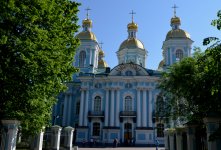 |
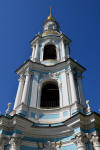 |
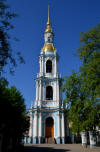 |
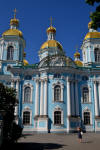 |
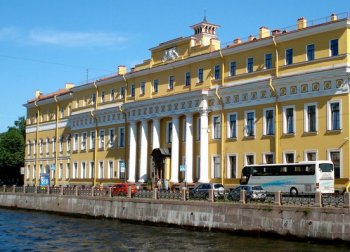 We
were then able to return to the Moika / Yusupov Palace. On 17
December 1916, this elegant yellow building on the banks of the
Moika River became the setting for one of history’s most
melodramatic murders: that of Grigori Rasputin by Prince Yusupov.
Rasputin was a mystic who, through his associations with the
monarchy and perceived ability to influence its decisions and
actions, ended up shouldering much of the blame for Russia's ills at
the time. We preferred the independent option of a self-guided tour
of the palace, the highlight of which was the building's little
rococo theatre, whose stage was once graced by the likes of Liszt
and Chopin.
We
were then able to return to the Moika / Yusupov Palace. On 17
December 1916, this elegant yellow building on the banks of the
Moika River became the setting for one of history’s most
melodramatic murders: that of Grigori Rasputin by Prince Yusupov.
Rasputin was a mystic who, through his associations with the
monarchy and perceived ability to influence its decisions and
actions, ended up shouldering much of the blame for Russia's ills at
the time. We preferred the independent option of a self-guided tour
of the palace, the highlight of which was the building's little
rococo theatre, whose stage was once graced by the likes of Liszt
and Chopin.
The morning's programme now complete, we returned to base to finish our preparations for departure.
 |
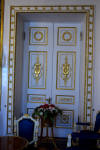 |
 |
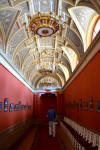 |
 |
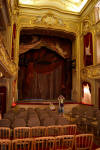 |
 |
 |
 |
Onwards to Sweden
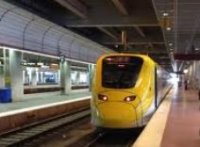
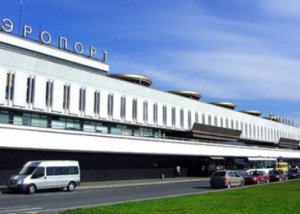 We
left plenty of time for our hotel-car transfer to the airport, as an
insurance against any disruption that might be caused by the
high-profile political summit that had been taking place in the city
throughout our visit and which had been attended by the Russian
president. The short SAS flight to Stockholm's Arlanda Airport was
noteable for being subject to the once celebrated Concorde
phenomenon of "arriving before you depart". On a 430-mile flight
where the point of departure was two hours ahead of the destination,
it's not difficult to work out why.
We
left plenty of time for our hotel-car transfer to the airport, as an
insurance against any disruption that might be caused by the
high-profile political summit that had been taking place in the city
throughout our visit and which had been attended by the Russian
president. The short SAS flight to Stockholm's Arlanda Airport was
noteable for being subject to the once celebrated Concorde
phenomenon of "arriving before you depart". On a 430-mile flight
where the point of departure was two hours ahead of the destination,
it's not difficult to work out why.
The normally super-efficient Arlanda Express (on this occasion subject to disruption due to track issues) and a short hop on the Stockholm metro completed the job and took us to our next base: the Hilton Slussen, situated on the northern shore of the island of Södermalm and overlooking the old town area of Gamla Stan. We had an even quieter evening than usual, simply settling into our new surroundings and coming to terms with the fact that our short visit to the world's largest country was already over.